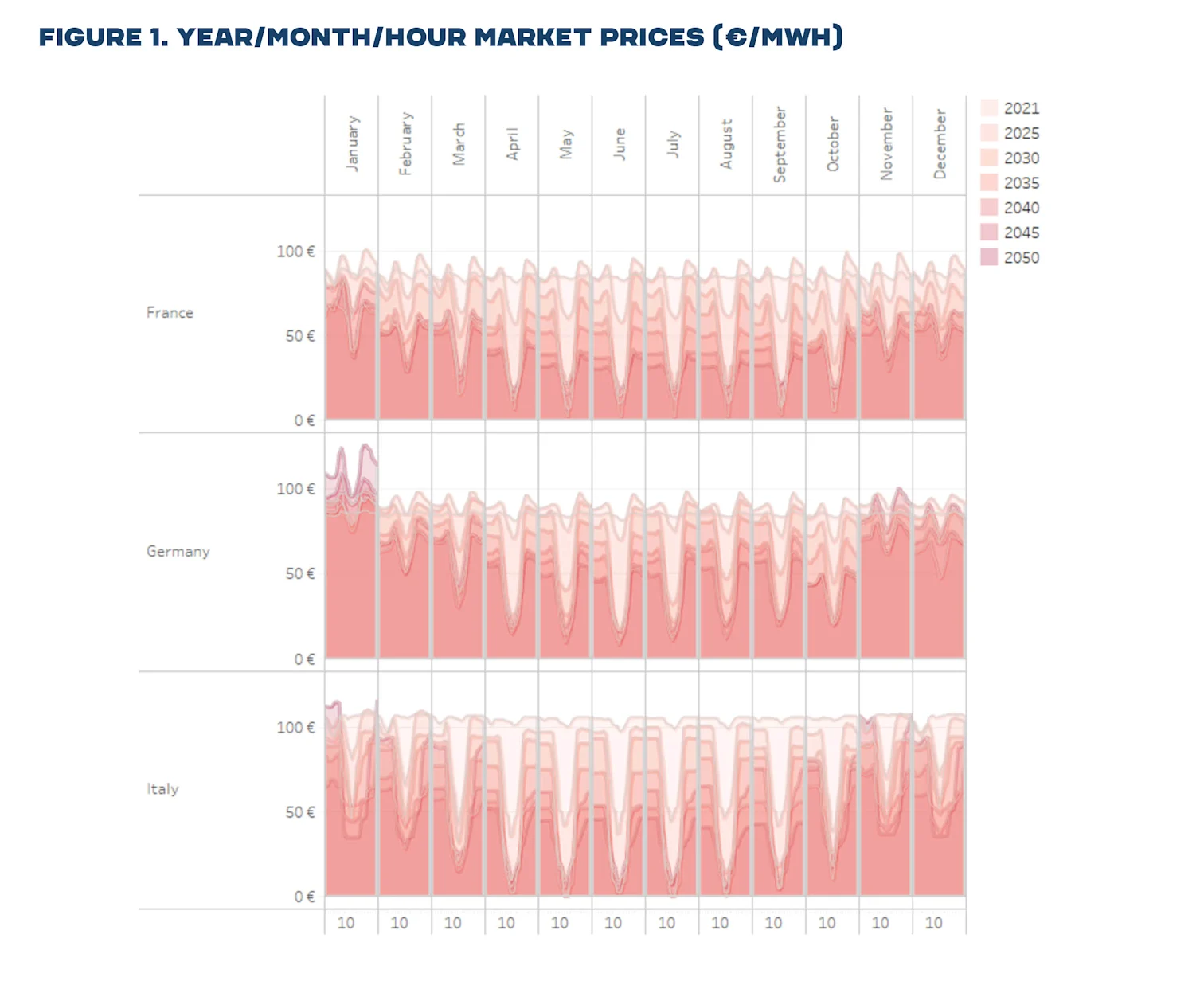Overview of CFE’s Modelling Analysis
In 2022, Carbon-Free Europe (CFE) released its first energy systems modelling analysis, identifying five pathways for the EU and UK to reach their 2050 net-zero emissions commitments. Starting in 2023, CFE will update our analysis annually to capture the changing energy and policy landscapes.
The Core pathway is the least constrained, allowing countries to use all available clean energy technologies and assuming high energy efficiency and electrification levels. This is the most feasible, cost-effective pathway to net-zero. The other scenarios explore how different policy and implementation constraints impact the route to carbon neutrality. To learn more, visit www.carbonfreeeurope.org/modelling.
Due to recent energy supply constraints and electricity price volatility, there is renewed appetite to reform the current EU electricity market under the Green Deal Industrial Plan. Carbon-Free Europe supports an electricity market restructuring that is equitable to all clean power technologies (both firm and intermittent), allows for reliable, secure, and affordable clean energy, and embeds emerging technologies, such as long duration energy storage, in a cohesive and resilient way.
Current Renewable Integration Flaws
In Carbon-Free Europe’s modelling, market prices, both in terms of the average annual price as well as price patterns, change dramatically with the introduction of hundreds of GWs of renewable generation. The chart below shows the significant pattern of solar generation in the middle of the day progressing through 2050.

This is not a stable investment environment for long-term assets without contractual support. While energy market prices maintain their value as a signal for balancing services, they are insufficient to support renewable energy deployment. Power Purchase Agreements (PPAs) and Contracts for Differences (CFDs) encourage long-term contracting vehicles to provide cost stability to consumers and reduce excess generator profits. While these contractual vehicles may have distorting effects on price and other market signals when applied under various scenarios, PPAs and CFDs will become increasingly important in providing revenue stability for renewables.
The Significance of Load Flexibility & Energy Storage

Market mechanisms that encourage load flexibility are critical: By 2050, in CFE’s Core pathway, we see 445 GWs of electricity load from hydrogen; 175 GWs of energy from flexible electric heat production; and 75 GWs of coincident end-use load flexibility from space conditioning, water heating, and vehicles. Carbon-Free Europe, therefore, supports the Commission’s efforts to enhance the use of end-use metering data, allow for further sub-metering of customer premise electricity loads, lower the minimum energy bid size to encourage the participation of smaller customers, and expand the use of demand response methods, like peak shaving. In the absence of the participation of these loads, which we term ‘latent storage’ (i.e., storage that already exists in the provision of an energy service), by 2050, we would see a need for an additional 130 GWs of energy storage to balance renewables and avoid peak impacts on the transmission and distribution system. Many of these loads can be optimized both temporally as well as spatially (EV charging, electrolysis, etc.), and information provided by Transmission System Operators (TSOs) in terms of current anticipated grid conditions will be important for their efficient deployment. Even with electricity load flexibility, we see the necessity to deploy hundreds of GWs of storage over the next three decades. However, in order to encourage installed durations (i.e., the amount of time storage can discharge continuously) adequate to meet long-term capacity needs, it’s an open question whether market revenues will be enough, as much of the installed capacity will only be discharged for a few hours every year.

Carbon-Free Europe welcomes the European Commission’s proposal to reform the EU’s electricity market design to align with the EU’s climate commitments, and to protect consumers, CFE therefore, provisionally supports the idea of a low-carbon capacity mechanism, with some caveats. First, much of the existing capacity payment support in Europe is provided to fossil and nuclear resources, with unlimited ability to sustain their energy production for any duration of time. Instead, co-legislators should consider that capacity remuneration will need to be differentiated by resource capabilities to procure an efficient set of flexibility resources. Second, we see an important role for thermal generators as they transition to backing up renewables and are called on only in the event of sustained low renewable outputs. This limited role naturally limits their emissions impacts. Market mechanisms must adequately compensate thermal generators for this continued role as backup generators, even as they run less and less over time and earn limited (and unpredictable) revenue in the electricity markets. If they are not adequately compensated in the electricity markets in the long-term and are not compensated for their capacity provision, this could significantly increase the costs of providing reliable electricity service in a high renewables environment. We see the need for over 500 GW of non-nuclear dispatchable thermal generation running only ~5% of the year in order to provide reliability in an electrified, highly renewable world.

Prioritizing Energy Consumer Protection
Carbon-Free Europe also supports some of the targeted energy consumer protection proposals in the EU including requiring the transparent appointment of last resort suppliers and improving the process for consumers who must be switched to these suppliers, clarifying the conditions and procedures under which an emergency can declare price support intervention, and protecting the EU’s most vulnerable citizens from disconnection—an imperative that becomes even more important as the EU transitions to a highly electrified future with over 50% of end-use energy satisfied by electricity.
Conclusion
As the EU institutions work to negotiate and finalize the Electricity Market Design reform as part of the Green Deal Industrial Plan, CFE stresses that the final agreement must accelerate the deployment of clean energy technologies in an equitable way. This should include a detailed plan on allowing flexibility via direct access to electricity markets, and reliability via the structural acknowledgement of capacity needs at certain durations.





